Kharkiv National University of Economics Management

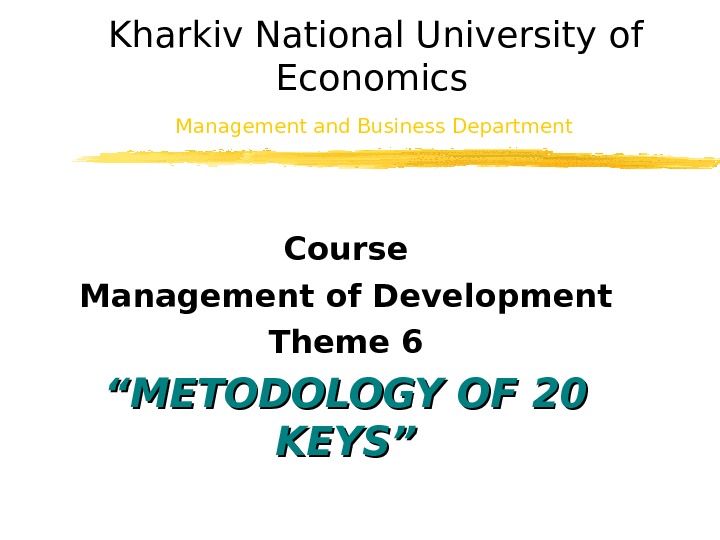
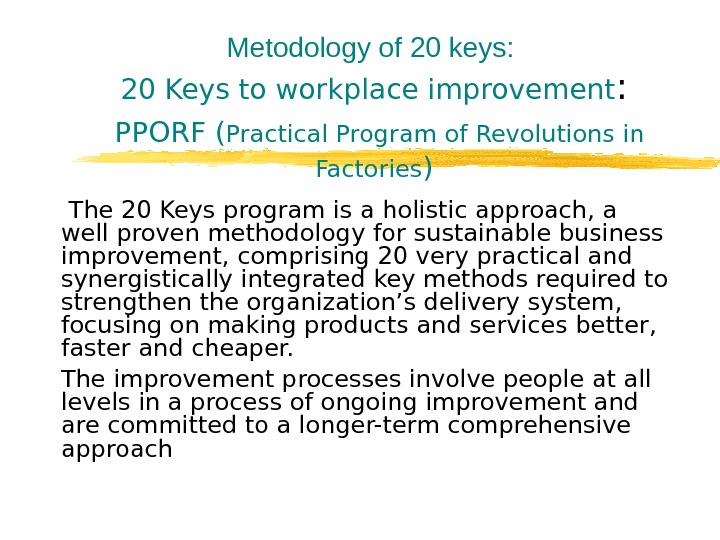
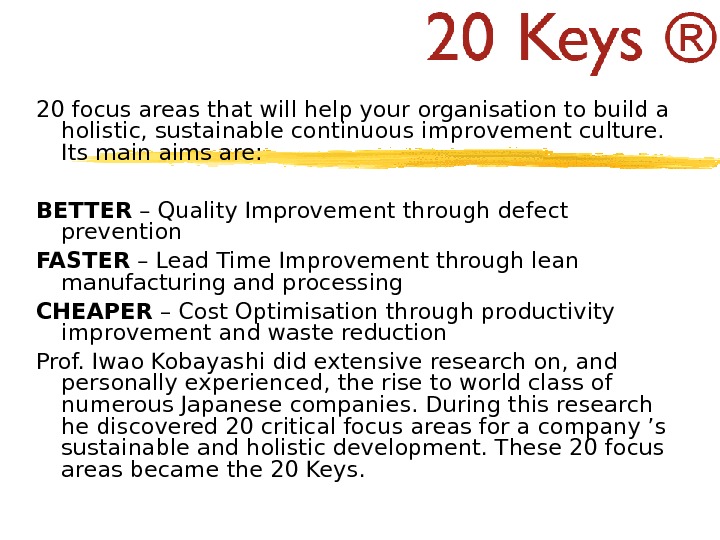
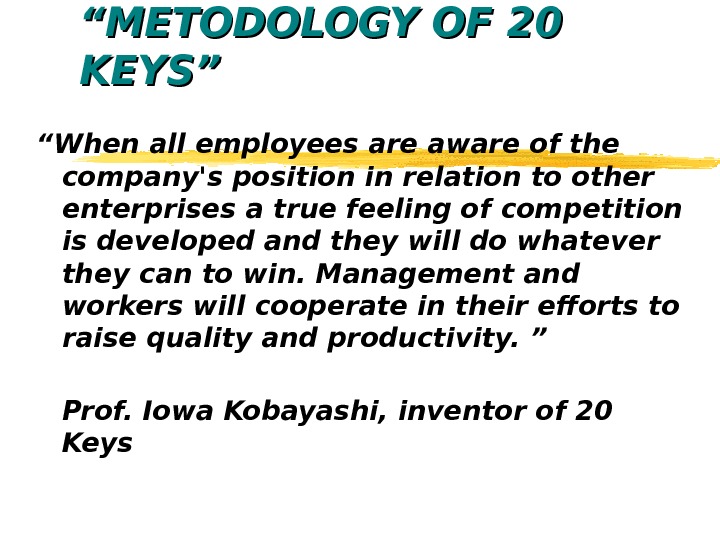

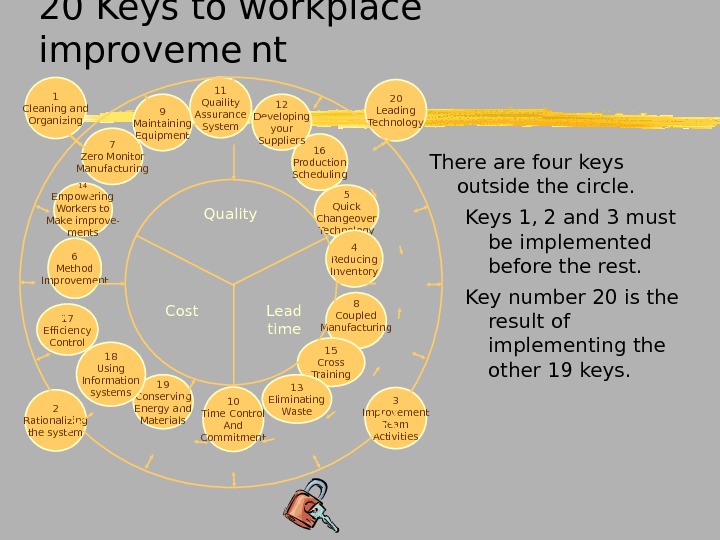
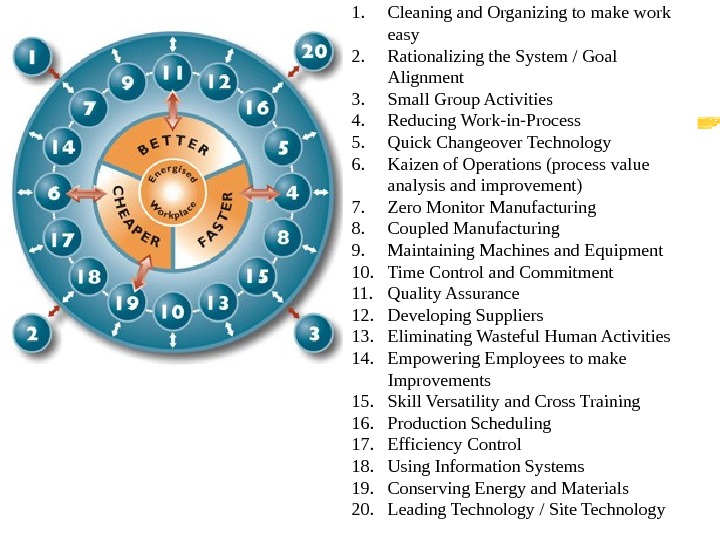

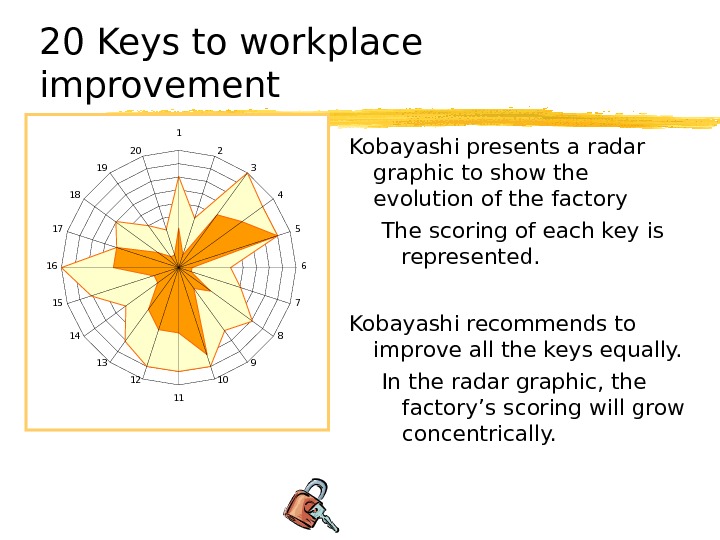
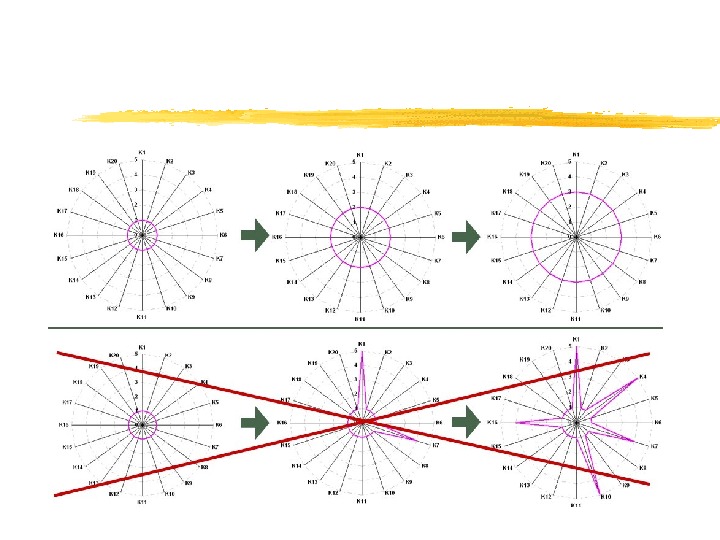
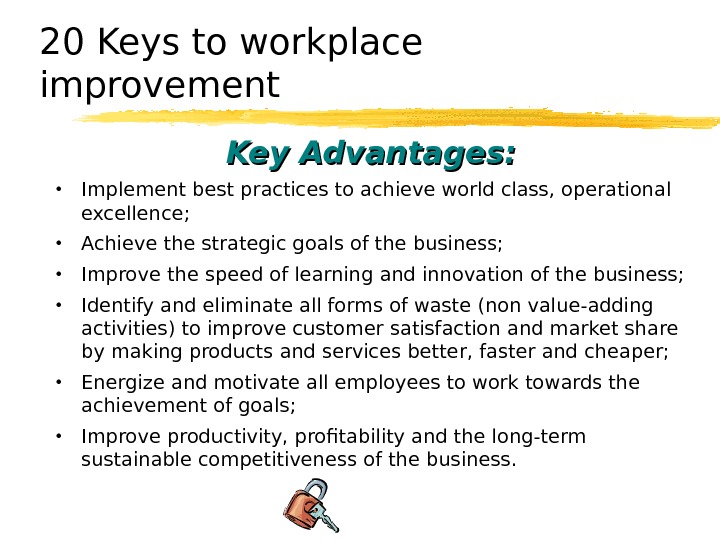
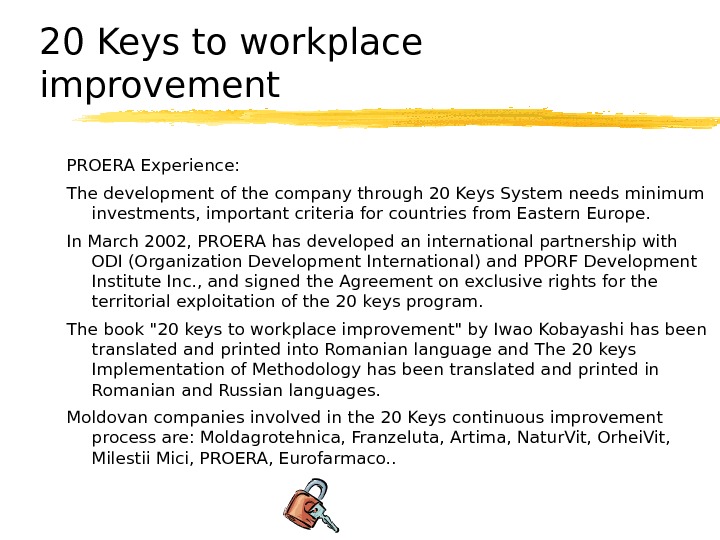
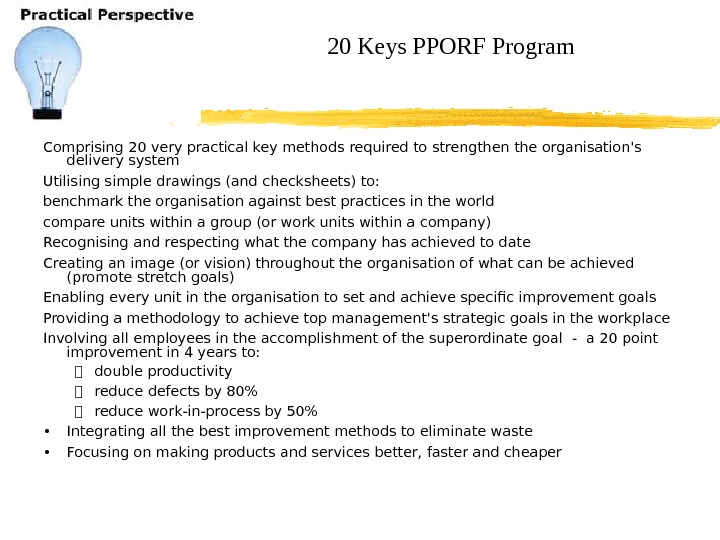

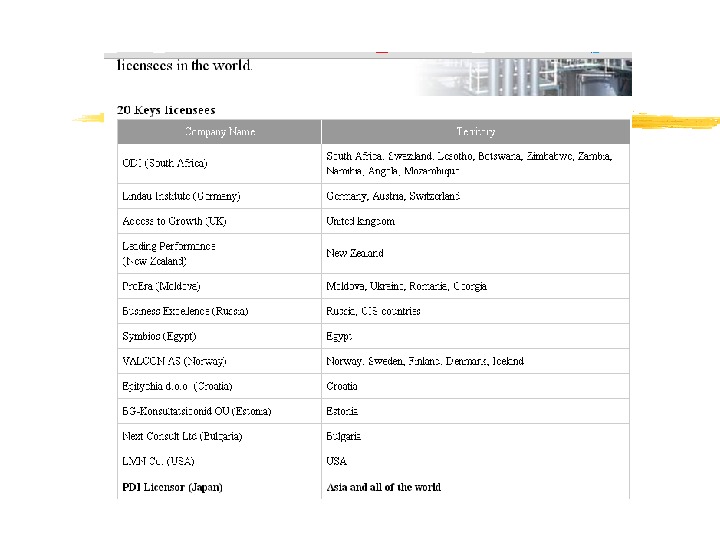
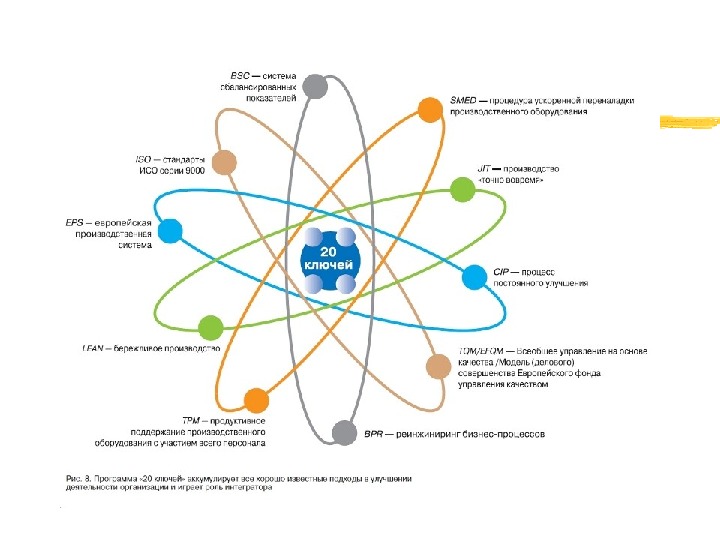

managemen_of_development_theme_6.ppt
- Размер: 824.5 Кб
- Количество слайдов: 17
Описание презентации Kharkiv National University of Economics Management по слайдам
 Kharkiv National University of Economics Management and Business Department Course Management of Development Theme 6 ““ METODOLOGY OF 20 KEYS ””
Kharkiv National University of Economics Management and Business Department Course Management of Development Theme 6 ““ METODOLOGY OF 20 KEYS ””
 Metodology of 20 keys : 20 Keys to workplace improvement : PPORF ( Practical Program of Revolutions in Factories ) The 20 Keys program is a holistic approach, a well proven methodology for sustainable business improvement, comprising 20 very practical and synergistically integrated key methods required to strengthen the organization’s delivery system, focusing on making products and services better, faster and cheaper. The improvement processes involve people at all levels in a process of ongoing improvement and are committed to a longer-term comprehensive approach
Metodology of 20 keys : 20 Keys to workplace improvement : PPORF ( Practical Program of Revolutions in Factories ) The 20 Keys program is a holistic approach, a well proven methodology for sustainable business improvement, comprising 20 very practical and synergistically integrated key methods required to strengthen the organization’s delivery system, focusing on making products and services better, faster and cheaper. The improvement processes involve people at all levels in a process of ongoing improvement and are committed to a longer-term comprehensive approach
 20 focus areas that will help your organisation to build a holistic, sustainable continuous improvement culture. Its main aims are: BETTER – Quality Improvement through defect prevention FASTER – Lead Time Improvement through lean manufacturing and processing CHEAPER – Cost Optimisation through productivity improvement and waste reduction Prof. Iwao Kobayashi did extensive research on, and personally experienced, the rise to world class of numerous Japanese companies. During this research he discovered 20 critical focus areas for a company ’s sustainable and holistic development. These 20 focus areas became the 20 Keys.
20 focus areas that will help your organisation to build a holistic, sustainable continuous improvement culture. Its main aims are: BETTER – Quality Improvement through defect prevention FASTER – Lead Time Improvement through lean manufacturing and processing CHEAPER – Cost Optimisation through productivity improvement and waste reduction Prof. Iwao Kobayashi did extensive research on, and personally experienced, the rise to world class of numerous Japanese companies. During this research he discovered 20 critical focus areas for a company ’s sustainable and holistic development. These 20 focus areas became the 20 Keys.
 ““ METODOLOGY OF 20 KEYS ”” “ When all employees are aware of the company’s position in relation to other enterprises a true feeling of competition is developed and they will do whatever they can to win. Management and workers will cooperate in their efforts to raise quality and productivity. ” Prof. Iowa Kobayashi, inventor of 20 Keys
““ METODOLOGY OF 20 KEYS ”” “ When all employees are aware of the company’s position in relation to other enterprises a true feeling of competition is developed and they will do whatever they can to win. Management and workers will cooperate in their efforts to raise quality and productivity. ” Prof. Iowa Kobayashi, inventor of 20 Keys
 520 Keys to workplace improvement : Iwao Kobayashi, in 1988, published a book explaining 20 keys to Workplace improvement. They all must be considered in order to achieve continuous improvement. These 20 keys are arranged in a circle. Shows the relations between the keys and their influence on the three main factors. Quality, cost and lead time.
520 Keys to workplace improvement : Iwao Kobayashi, in 1988, published a book explaining 20 keys to Workplace improvement. They all must be considered in order to achieve continuous improvement. These 20 keys are arranged in a circle. Shows the relations between the keys and their influence on the three main factors. Quality, cost and lead time.
 20 Keys to workplace improveme nt There are four keys outside the circle. Keys 1, 2 and 3 must be implemented before the rest. Key number 20 is the result of implementing the other 19 keys. 20 Leading Technology 16 Production Scheduling 12 Developing your Suppliers 11 Quaility Assurance System 9 Maintaining Equipment 7 Zero Monitor Manufacturing 14 Empowering Workers to Make improve- ments 5 Quick Changeover Technology 4 Reducing Inventory 8 Coupled Manufacturing 15 Cross Training 13 Eliminating Waste 10 Time Control And Commitment 19 Conserving Energy and Materials 18 Using Information systems 17 Efficiency Control 6 Method Improvement 1 Cleaning and Organizing 2 Rationalizing the system 3 Improvement Team Activities. Quality Cost Lead time
20 Keys to workplace improveme nt There are four keys outside the circle. Keys 1, 2 and 3 must be implemented before the rest. Key number 20 is the result of implementing the other 19 keys. 20 Leading Technology 16 Production Scheduling 12 Developing your Suppliers 11 Quaility Assurance System 9 Maintaining Equipment 7 Zero Monitor Manufacturing 14 Empowering Workers to Make improve- ments 5 Quick Changeover Technology 4 Reducing Inventory 8 Coupled Manufacturing 15 Cross Training 13 Eliminating Waste 10 Time Control And Commitment 19 Conserving Energy and Materials 18 Using Information systems 17 Efficiency Control 6 Method Improvement 1 Cleaning and Organizing 2 Rationalizing the system 3 Improvement Team Activities. Quality Cost Lead time
 71. Cleaning and Organizing to make work easy 2. Rationalizing the System / Goal Alignment 3. Small Group Activities 4. Reducing Work-in-Process 5. Quick Changeover Technology 6. Kaizen of Operations (process value analysis and improvement) 7. Zero Monitor Manufacturing 8. Coupled Manufacturing 9. Maintaining Machines and Equipment 10. Time Control and Commitment 11. Quality Assurance 12. Developing Suppliers 13. Eliminating Wasteful Human Activities 14. Empowering Employees to make Improvements 15. Skill Versatility and Cross Training 16. Production Scheduling 17. Efficiency Control 18. Using Information Systems 19. Conserving Energy and Materials 20. Leading Technology / Site Technology
71. Cleaning and Organizing to make work easy 2. Rationalizing the System / Goal Alignment 3. Small Group Activities 4. Reducing Work-in-Process 5. Quick Changeover Technology 6. Kaizen of Operations (process value analysis and improvement) 7. Zero Monitor Manufacturing 8. Coupled Manufacturing 9. Maintaining Machines and Equipment 10. Time Control and Commitment 11. Quality Assurance 12. Developing Suppliers 13. Eliminating Wasteful Human Activities 14. Empowering Employees to make Improvements 15. Skill Versatility and Cross Training 16. Production Scheduling 17. Efficiency Control 18. Using Information Systems 19. Conserving Energy and Materials 20. Leading Technology / Site Technology
 20 Keys to workplace improvement Kobayashi divided each key into five levels and set some criteria to rise from one level to the next. Kobayashi offers the steps to reach the final level gradually rather than attempting to directly reach the top.
20 Keys to workplace improvement Kobayashi divided each key into five levels and set some criteria to rise from one level to the next. Kobayashi offers the steps to reach the final level gradually rather than attempting to directly reach the top.
 20 Keys to workplace improvement Kobayashi presents a radar graphic to show the evolution of the factory The scoring of each key is represented. Kobayashi recommends to improve all the keys equally. In the radar graphic, the factory’s scoring will grow concentrically.
20 Keys to workplace improvement Kobayashi presents a radar graphic to show the evolution of the factory The scoring of each key is represented. Kobayashi recommends to improve all the keys equally. In the radar graphic, the factory’s scoring will grow concentrically.

 20 Keys to workplace improvement Key Advantages: • Implement best practices to achieve world class, operational excellence; • Achieve the strategic goals of the business; • Improve the speed of learning and innovation of the business; • Identify and eliminate all forms of waste (non value-adding activities) to improve customer satisfaction and market share by making products and services better, faster and cheaper; • Energize and motivate all employees to work towards the achievement of goals; • Improve productivity, profitability and the long-term sustainable competitiveness of the business.
20 Keys to workplace improvement Key Advantages: • Implement best practices to achieve world class, operational excellence; • Achieve the strategic goals of the business; • Improve the speed of learning and innovation of the business; • Identify and eliminate all forms of waste (non value-adding activities) to improve customer satisfaction and market share by making products and services better, faster and cheaper; • Energize and motivate all employees to work towards the achievement of goals; • Improve productivity, profitability and the long-term sustainable competitiveness of the business.
 20 Keys to workplace improvement PROERA Experience: The development of the company through 20 Keys System needs minimum investments, important criteria for countries from Eastern Europe. In March 2002, PROERA has developed an international partnership with ODI (Organization Development International) and PPORF Development Institute Inc. , and signed the Agreement on exclusive rights for the territorial exploitation of the 20 keys program. The book «20 keys to workplace improvement» by Iwao Kobayashi has been translated and printed into Romanian language and The 20 keys Implementation of Methodology has been translated and printed in Romanian and Russian languages. Moldovan companies involved in the 20 Keys continuous improvement process are: Moldagrotehnica, Franzeluta, Artima, Natur. Vit, Orhei. Vit, Milestii Mici, PROERA, Eurofarmaco. .
20 Keys to workplace improvement PROERA Experience: The development of the company through 20 Keys System needs minimum investments, important criteria for countries from Eastern Europe. In March 2002, PROERA has developed an international partnership with ODI (Organization Development International) and PPORF Development Institute Inc. , and signed the Agreement on exclusive rights for the territorial exploitation of the 20 keys program. The book «20 keys to workplace improvement» by Iwao Kobayashi has been translated and printed into Romanian language and The 20 keys Implementation of Methodology has been translated and printed in Romanian and Russian languages. Moldovan companies involved in the 20 Keys continuous improvement process are: Moldagrotehnica, Franzeluta, Artima, Natur. Vit, Orhei. Vit, Milestii Mici, PROERA, Eurofarmaco. .
 Comprising 20 very practical key methods required to strengthen the organisation’s delivery system Utilising simple drawings (and checksheets) to: benchmark the organisation against best practices in the world compare units within a group (or work units within a company) Recognising and respecting what the company has achieved to date Creating an image (or vision) throughout the organisation of what can be achieved (promote stretch goals) Enabling every unit in the organisation to set and achieve specific improvement goals Providing a methodology to achieve top management’s strategic goals in the workplace Involving all employees in the accomplishment of the superordinate goal — a 20 point improvement in 4 years to: double productivity reduce defects by 80% reduce work-in-process by 50% • Integrating all the best improvement methods to eliminate waste • Focusing on making products and services better, faster and cheaper 20 Keys PPORF Program
Comprising 20 very practical key methods required to strengthen the organisation’s delivery system Utilising simple drawings (and checksheets) to: benchmark the organisation against best practices in the world compare units within a group (or work units within a company) Recognising and respecting what the company has achieved to date Creating an image (or vision) throughout the organisation of what can be achieved (promote stretch goals) Enabling every unit in the organisation to set and achieve specific improvement goals Providing a methodology to achieve top management’s strategic goals in the workplace Involving all employees in the accomplishment of the superordinate goal — a 20 point improvement in 4 years to: double productivity reduce defects by 80% reduce work-in-process by 50% • Integrating all the best improvement methods to eliminate waste • Focusing on making products and services better, faster and cheaper 20 Keys PPORF Program
 There are five levels in each of the 20 Keys. These five levels are explained in a pictorial map of each Key as well as in a checksheet format By using the 20 Keys, 5 -point multi-industry, international benchmarking system, the organisation or department or a section of the organisation can be evaluated an overall 20 Keys score determined. A 20 Keys evaluation should be made by most managers as well as a representative sample of employees or through a thorough audit at least twice a year. This evaluation is then presented in the form of a radar chart presenting the constitution or capability of the organisation. The purpose of benchmarking is to determine where you are today in terms of global best practices and where you would like to be tomorrow. In determining where you are and in making the transition, the 20 Keys provides the company with practical simple steps and stresses the synergistic effects created by the interrelationships of all the Keys. 20 Keys PPORF Program
There are five levels in each of the 20 Keys. These five levels are explained in a pictorial map of each Key as well as in a checksheet format By using the 20 Keys, 5 -point multi-industry, international benchmarking system, the organisation or department or a section of the organisation can be evaluated an overall 20 Keys score determined. A 20 Keys evaluation should be made by most managers as well as a representative sample of employees or through a thorough audit at least twice a year. This evaluation is then presented in the form of a radar chart presenting the constitution or capability of the organisation. The purpose of benchmarking is to determine where you are today in terms of global best practices and where you would like to be tomorrow. In determining where you are and in making the transition, the 20 Keys provides the company with practical simple steps and stresses the synergistic effects created by the interrelationships of all the Keys. 20 Keys PPORF Program


 http: //www. devbusiness. ru/development/restructuring/20 Keys _UAMC. htm
http: //www. devbusiness. ru/development/restructuring/20 Keys _UAMC. htm

